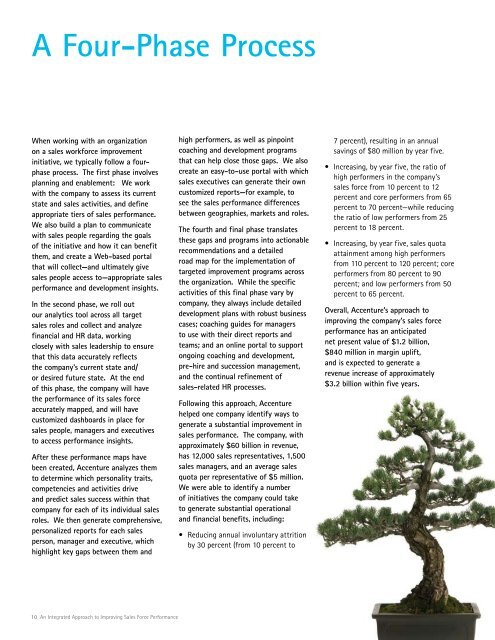Sales Competency, Behavior and Personality
Sales Competency, Behavior and Personality
Sales Competency, Behavior and Personality
You also want an ePaper? Increase the reach of your titles
YUMPU automatically turns print PDFs into web optimized ePapers that Google loves.
A Four-Phase Process<br />
When working with an organization<br />
on a sales workforce improvement<br />
initiative, we typically follow a fourphase<br />
process. The first phase involves<br />
planning <strong>and</strong> enablement: We work<br />
with the company to assess its current<br />
state <strong>and</strong> sales activities, <strong>and</strong> define<br />
appropriate tiers of sales performance.<br />
We also build a plan to communicate<br />
with sales people regarding the goals<br />
of the initiative <strong>and</strong> how it can benefit<br />
them, <strong>and</strong> create a Web-based portal<br />
that will collect—<strong>and</strong> ultimately give<br />
sales people access to—appropriate sales<br />
performance <strong>and</strong> development insights.<br />
In the second phase, we roll out<br />
our analytics tool across all target<br />
sales roles <strong>and</strong> collect <strong>and</strong> analyze<br />
financial <strong>and</strong> HR data, working<br />
closely with sales leadership to ensure<br />
that this data accurately reflects<br />
the company’s current state <strong>and</strong>/<br />
or desired future state. At the end<br />
of this phase, the company will have<br />
the performance of its sales force<br />
accurately mapped, <strong>and</strong> will have<br />
customized dashboards in place for<br />
sales people, managers <strong>and</strong> executives<br />
to access performance insights.<br />
After these performance maps have<br />
been created, Accenture analyzes them<br />
to determine which personality traits,<br />
competencies <strong>and</strong> activities drive<br />
<strong>and</strong> predict sales success within that<br />
company for each of its individual sales<br />
roles. We then generate comprehensive,<br />
personalized reports for each sales<br />
person, manager <strong>and</strong> executive, which<br />
highlight key gaps between them <strong>and</strong><br />
10 An Integrated Approach to Improving <strong>Sales</strong> Force Performance<br />
high performers, as well as pinpoint<br />
coaching <strong>and</strong> development programs<br />
that can help close those gaps. We also<br />
create an easy-to-use portal with which<br />
sales executives can generate their own<br />
customized reports—for example, to<br />
see the sales performance differences<br />
between geographies, markets <strong>and</strong> roles.<br />
The fourth <strong>and</strong> final phase translates<br />
these gaps <strong>and</strong> programs into actionable<br />
recommendations <strong>and</strong> a detailed<br />
road map for the implementation of<br />
targeted improvement programs across<br />
the organization. While the specific<br />
activities of this final phase vary by<br />
company, they always include detailed<br />
development plans with robust business<br />
cases; coaching guides for managers<br />
to use with their direct reports <strong>and</strong><br />
teams; <strong>and</strong> an online portal to support<br />
ongoing coaching <strong>and</strong> development,<br />
pre-hire <strong>and</strong> succession management,<br />
<strong>and</strong> the continual refinement of<br />
sales-related HR processes.<br />
Following this approach, Accenture<br />
helped one company identify ways to<br />
generate a substantial improvement in<br />
sales performance. The company, with<br />
approximately $60 billion in revenue,<br />
has 12,000 sales representatives, 1,500<br />
sales managers, <strong>and</strong> an average sales<br />
quota per representative of $5 million.<br />
We were able to identify a number<br />
of initiatives the company could take<br />
to generate substantial operational<br />
<strong>and</strong> financial benefits, including:<br />
• Reducing annual involuntary attrition<br />
by 30 percent (from 10 percent to<br />
7 percent), resulting in an annual<br />
savings of $80 million by year five.<br />
• Increasing, by year five, the ratio of<br />
high performers in the company’s<br />
sales force from 10 percent to 12<br />
percent <strong>and</strong> core performers from 65<br />
percent to 70 percent—while reducing<br />
the ratio of low performers from 25<br />
percent to 18 percent.<br />
• Increasing, by year five, sales quota<br />
attainment among high performers<br />
from 110 percent to 120 percent; core<br />
performers from 80 percent to 90<br />
percent; <strong>and</strong> low performers from 50<br />
percent to 65 percent.<br />
Overall, Accenture’s approach to<br />
improving the company’s sales force<br />
performance has an anticipated<br />
net present value of $1.2 billion,<br />
$840 million in margin uplift,<br />
<strong>and</strong> is expected to generate a<br />
revenue increase of approximately<br />
$3.2 billion within five years.

















